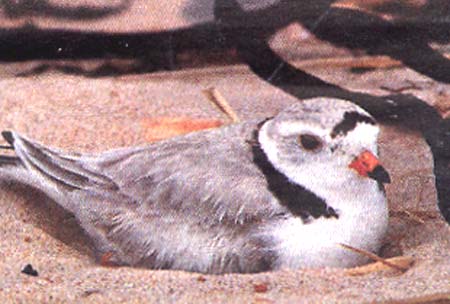Special to the Atlantic News
Atlantic News, Friday, August 22, 2008
[The following article is courtesy of Atlantic News]

SEACOAST -- It has been a productive summer for the federally-threatened and state-endangered piping plovers that nested in New Hampshire this spring.
New Hampshire Fish and Game's Samantha Niziolek, the piping plover monitor for the department's Nongame and Endangered Wildlife Program, recently confirmed that three chicks had fledged from Seabrook Beach. This was in addition to the three chicks that fledged from Hampton Beach State Park at the end of June.
Three pairs of piping plovers established nests in New Hampshire this year — one at Hampton Beach State Park and two at Seabrook Beach. While one nest in Seabrook failed shortly after hatching, three of the four chicks from both of the other nests survived to fledge and are now gearing up for their migration south for the winter.
The plovers were fortunate not to have any of their nests destroyed by high tides this spring," said Brendan Clifford, a biological technician with the Nongame Program. "In recent years, strong spring storms have forced many pairs to re- nest, putting additional stress on the birds."
This year, the chicks at Hampton Beach State Park fledged early and were able to avoid the large Fourth of July crowds.
Every spring, Nongame Program staff and volunteers set up symbolic fencing along Hampton Beach State Park and Seabrook Beach to protect the nesting habitat of the plovers. Once nests have been established and located, predator exclosures (that is, wire cages) are placed around the eggs to prevent predators such as skunks, gulls and crows from destroying them.
After hatching, tiny plover chicks must avoid numerous potential predators, including feral cats, domestic dogs and gulls, as well as beachgoers who get too close.
Designated a threatened species by the federal government, piping plovers have been the focus of a massive region-wide effort along the Atlantic Coast from the Carolinas to Newfoundland. New Hampshire Fish and Game's Nongame Program has provided protection and monitoring for this rare bird in New Hampshire since 1996. In the past decade, an average of five nesting pairs has returned to the New Hampshire Seacoast each year, and a total of 81 chicks have successfully fledged in New Hampshire.
Volunteer monitoring is vital to the success of the piping plover project. Volunteers monitor the activity of the adults and chicks and inform beach visitors of the protection efforts. Anyone interested in volunteering next summer should contact Brendan Clifford at (603) 271-0463 or Brendan.Clifford@wildlife.nh.gov.
Protection of this endangered species in New Hampshire is a cooperative effort of the US Fish and Wildlife Service, NH Fish and Game, NH Parks and Recreation, the towns of Seabrook and Hampton, volunteers, local residents and beach visitors. Funding for the habitat protection and monitoring effort is provided in part from federal aid grants, sales of the NH conservation license plate (Moose Plate) and from private donations to the Nongame and Endangered Wildlife Program.
